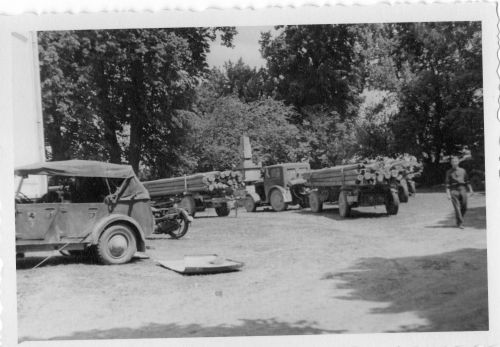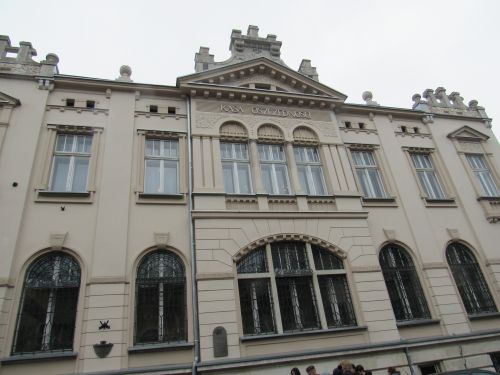Jozefow

Jozefow - German troops occupy the town (Chris Webb Private Archive)
Jozefow near Bilgoraj, was a typical Eastern Polish shtel. Before the Second World War its Jewish population numbered approximately 2,000, which equated to 60 % of the total population. The Jewish community was established at the beginning of the 18th Century, and the town itself became established in the 19th Century. Jozefow became known for its very famous Jewish paper mill, leased by the Wax family, which published Hebrew religious books, which were sold internationally. A great number of the Jews made a living from selling religious books in Hebrew but the town was a poor provincial town, and a few decades later the printing house went bankrupt, as it could not compete with more modern printing houses in Lublin, Warsaw and Vilnius.
At the outbreak of the Second World War in September 1939, Jozefow was bombed by the German Luftwaffe and a large part of the town centre was destroyed. At the end of September 1939, as part of the Ribbentrop- Molotov pact the Soviet Army entered Jozefow, but after a short occupation they left the town. Approximately 1,000 local Jews decided to go with them and settle in the Soviet Union. Only the very poor stayed in Jozefow.
At the beginning of the German occupation life went on as normal for the Jewish population. A Jewish Council (Judenrat) was formed and at is head was president Baruch Goldsztajn, and amongst its members was the local pre-war rabbi Szymon Parzenczewski. However, things started to change for the worse, when on March 18, 1941, approximately 1,100 Jews were resettled from Konin, which was part of the so-called Warthegau. These Jews were very poor, who had lost all their property and possessions. There were also a number of elderly and sick people. The new arrivals had to live together with the local inhabitants in overcrowded houses. After a short while problems with the supply of food and deteriorating hygiene, became major causes for concern. Because of the extremely primitive living conditions, a typhus epidemic broke out, especially among the Jews deported from Konin. During 1941/42, Jozefow became the centre of this typhus epidemic in the Bilgoraj County. It is important to note that there was no hospital, nor a Jewish doctor in the village, only an 'isolation house' which was too small to accommodate all the sick people. Among the Jews from Konin were two dentists, but they possessed no medical equipment.
Former JSS Building -Krakow 2016 (Chris Webb Archives)
The conditions in Jozefow were described in a letter sent in 1941, by resettled Jews from Konin, to the Jewish Social Self-Help in Krakow:
'We are in a small town, destroyed because of the war, among very poor people, who in fact need our help. We are living in very bad conditions. We feel mainly the lack of food, clothing and shoes, because we have lost everything.' The resettled Jews sent another letter to the JSS in Krakow, written by M. Furszt, the representative of the Jews from Konin, who worked in the community kitchen, who wrote:
'There is no way for us to earn anything. The majority 'are living' on what they can sell -clothes and linen. And even these things are almost finished. We are the leading place in the whole Lublin district for the number of people who have typhus. Death from starvation and hunger is visiting every home. It is horrible to see how our children, emaciated and pale-faced are going from house to house pleading for bread.'
During August 1941, living conditions became even worse when several Jewish houses were burned down at night. Approximately 200 people lost the little property they had and were made homeless. At that time, according to a Judenrat report 2,147 Jews lived in Jozefow. At the beginning of 1942, official rations for the Jews were 72 grams of bread a day and 200 grams of sugar a month. In addition to this, they sometimes were provided with 60 grams of soap and 1 litre of paraffin.
The first German 'aktion' which took place in Jozefow on May 1, 1942, when members of the Gestapo from Bilgoraj arrived in the village, and they arrested 20 Jews from the village, whose names were on a specially prepared list. They were accused of being Communists, and were taken to the Gestapo prison in Bilgoraj. It is possible from there they were sent to Lublin Concentration Camp, but that has never been established. A few days later on May 11, 1942, three members of the Bilgoraj Gestapo, organised a special 'aktion' in Jozefow, where 130 Jews were murdered in the streets and a local quarry.
This was a portent of more sinister atrocities that followed in that summer of 1942. Reserve Police Battalion 101, under the command of Major Willhelm Trapp arrived in Jozefow on July 13, 1942. Here the Jewish inhabitants were collected in the market square, packed into trucks and taken to the forest, to a place on the road to Bilgoraj, known to the locals as the Winiarczykowa Gora. The elderly, woman and children were shot, whilst the men were taken to labour camps in Lublin. The Reserve Police Battalion 101 murdered some 1,500 Jews that day. Today there is a stone memorial monument in the forest in the direction of Aleksandrow and Bilgoraj. (Please see the Police Battalion 101 webpage, for more information about the massacre).
Those Jews who somehow avoided the massacre, were joined by new arrivals, mainly from nearby villages, that were forced to resettle in Jozefow. This number swelled to between 300 -400 Jews. Among them was Estera Fefer, from Krakow, who was resettled to Lukowa, a village near Jozefow. She survived and wrote an account:
'Jozefow was a town of death. The people were killed without an 'Aktion,' for no reason. At Yom Kippur they (the Germans) took people according to a list of names. Officially there were 20 names on the list, but they took 70 people. They were taken to the fire station where they were beaten horribly and then were shot in the quarry behind the town, near the forest. During this 'aktion' the local Polish population was very helpful.'
This group of people were murdered because Robert Kolb, the chief of the Gestapo in Bilgoraj ordered a high contribution to be gathered from the Jews in Jozefow, but the Jewish community did not give him the money in time, thus these 70 hostages were executed. This took place in September 1942.
On November 3, 1942, the final 'aktion' in Jozefow was carried out to make the town 'Judenfrei' - free of Jews. The man responsible for this final liquidation was Werner, the commander of the Schupo from nearby Dlugi Kat. As well as members of the Schutzpolizei, members of the Railway Police and members of the Polish Police also participated in the final 'action.' All those Jews who did not escape to the forest were first gathered in the Fire Station and then were forced to march to the railway station in Dlugi Kat. Those who could not keep up with the pace of the marchers were shot, and their mass grave at Chojniasta Gora. Between 200 and 300 Jews were deported to the Belzec death camp. These were in fact the last deportations to Belzec from Bilgoraj County.
Throughout November and December 1942, the Schutzpolizei and Bahnschutz- Polizei organised round-ups in Jozefow and the surrounding area, looking for hidden Jews. Those who were caught were locked up in the Jozefow prison. When groups between 10 -15 were collected they were executed near the new school building in Jozefow. Some of the Jews in the forest were murdered by local farmers, who wanted to rob these unarmed groups of whatever they had.
During 1943, Polish and Soviet partisan units operated in the region and some Jews joined these groups. In the area around Jozefow battles between the Germans and the partisans took place, especially after June -July 1943, when the Germans organised large-scale pacification 'aktions.' Even more fierce clashes took place during June 1944. In July 1944, the Soviet Army entered the region and a small group of survivors were liberated, which included Estera Fefer and members of her family.
Sources
R.Kuwalek, From Lublin to Belzec, AD Rem, Lublin, 2006
Archives of the Jewish Historical Institute in Warsaw: Documents of Judische Soziale Selbsthilfe: Testimony by Estera Fefer
Christopher R. Browning, Ordinary Men - Reserve Police Battalion 101 and the Final Solution in Poland, HarperPerennial 1998
Photographs: Chris Webb Archives
© Holocaust Historical Society February 26, 2021


